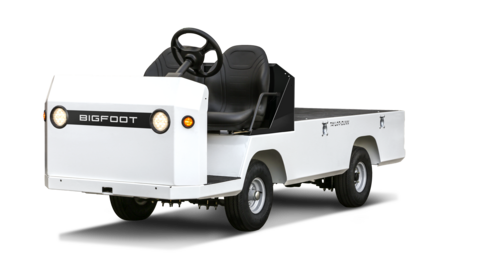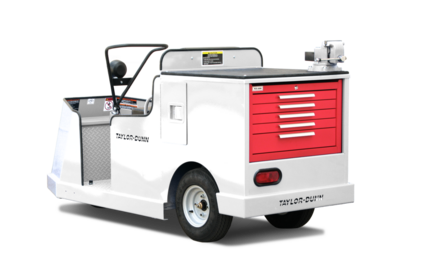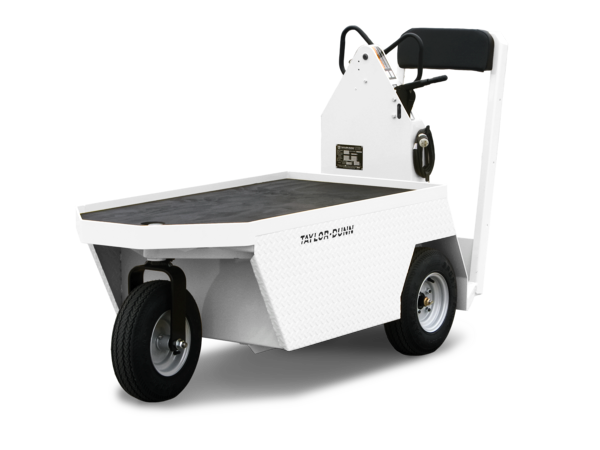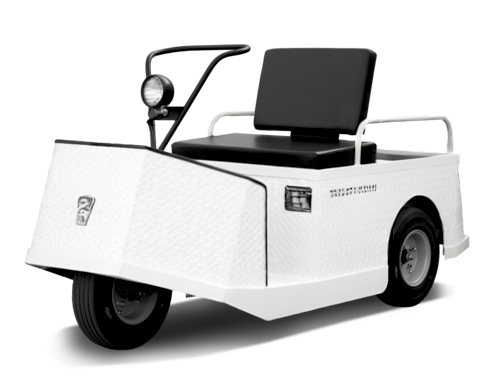Even the toughest vehicles have a maximum load capacity. This article includes information on hauling cargo and weight limits for your Taylor-Dunn vehicle.
Loading Cargo
Warning: DO NOT transport or load cargo in the front passenger area or leave loose items on the front floorboard. Cargo placed in the front passenger area may interfere with the driver, causing loss of control of the vehicle and resulting in a collision or accident with severe injury.
Warning: DO NOT place any cargo on the driver or passenger seats. Any object placed on the driver seat may activate the operator presence switch. Any object placed on the passenger seat may fall onto the driver seat and activate the switch, resulting in unexpected movement of the vehicle and causing severe bodily injury and/or property damage.
Before loading or unloading cargo:
1. Place the Direction Control switch in the center OFF position.
2. Turn the start switch OFF
3. Set the parking brake.
- Do not transport cargo that is wider than the vehicle.
- Do not load cargo in the passenger compartments.
- Use only Taylor-Dunn-approved cargo accessories.
- Do not exceed the load capacity of the vehicle.
- The standard designated cargo area is the rear deck. Only load cargo on the deck unless the vehicle has been equipped with Taylor-Dunn-approved alternative cargo storage areas.
- Cargo shall only be transported in the designated cargo area of the vehicle and evenly distributed with the center of gravity close to the center of the designated cargo area.
- All cargo shall be secured to prevent falling from the vehicle or shifting position while the vehicle is in motion.
- Our deck enclosures and covers such as cabs, fiberglass tops, surrey tops, cargo boxes and similar structures are not designed to carry cargo or accessories unless equipped from the factory. Mounting additional weight on these structures may result in sudden failure of the cover and/or cover supports, causing severe personal injury.
- Cargo consisting of fluid in tanks shall have fluid baffles in the tank to help reduce sloshing and shifting load weight.
- Pets should only be transported in a pet carrier that is securely tied down on the rear cargo deck.
- Always center the load on the cargo deck.
Vehicle Load Capacity
The load capacity is the maximum weight that can be carried on a vehicle under ideal conditions.
The rated maximum load capacity of a vehicle is the load carrying capacity of the standard model. The maximum load is on the vehicle’s data plate. Note: Occupants and equipment added to the vehicle reduces the capacity.
Example: Standard Load Capacity = 3,000 pounds (1,360 kg)
3,000 – Driver (200) – Steel Cab/Doors Option (300) – Cargo Box (400) = 2,100 pounds (952 kg) maximum load on deck.
Add a passenger (200 lb/90 kg), and the maximum load is reduced to 1,900 pounds (861 kg).
There are many conditions that will reduce the maximum safe load a vehicle can carry. Some of these conditions are, but not limited to:
- Uneven road surface
- Tall loads
- Wide loads
- Long loads
- Liquid loads (sloshing)
- Traveling up or down grades
- Traveling across grades
The rated capacity assumes the load has a low center of gravity and is centered on the deck.
For example: A 20-foot-tall, 3,000-pound statue on the deck of a 3,000-pound capacity vehicle is not approved.
Note that liquid loads sloshing around in a tank will shift the center of gravity and may result in stability and braking issues. Liquid loads must be secured and have fluid baffles in the tank to help reduce shifting load weight due to sloshing.
Draw Bar Pull (DBP)
Draw Bar Pull (DBP) is a measure of pulling force required to move a load. The load may be a trailing load or a pushed load. It is normally expressed in pounds or Newtons. The DBP of a tow tractor is the horizontal force exerted on a load at its coupler while towing or pushing a load. To measure the DBP, a scale would be connected in line with the tractor coupler and the load. The scale will directly read the DBP as the tractor tows the load.
Tow tractor DBP definitions:
- Normal DBP: Highest DBP that can be sustained for a given duty cycle.
- Ultimate DBP: Also referred to as Maximum DBP. Highest DBP achieved while traveling at a minimum speed of approximately 0.5 mph (0.8 kph) for a minimum of 30 seconds. This specification is used in calculations for getting a load moving.
Tow tractor DBP specifications are based on:
- Road surface consisting of level, dry, clean asphalt, brushed concrete or equivalent.
- Maximum battery weight installed per tow tractor battery specification.
Note that towing a load up any grade will significantly increase the DBP required. Most paved roads and parking lots have a drainage grade to allow water to run off. When operating a tow tractor at or near its maximum capacity, this drainage grade will significantly affect the DBP required to pull the load and may result in exceeding the tractor specifications.
The load capacity and towing capacity of a burden carrier cannot be combined. The towing capacity is reduced as weight is added to the burden carrier. This weight includes the passengers and optional equipment, as well as the load on the deck.
To calculate reduced towing capacity DBP, use this formula: Reduced DBP = DBP – Vl * (DBP/Vc)
- Vc = Vehicle Rated Capacity
- DBP = Normal Draw Bar Pull specification
- Vl = Vehicle Load (includes passengers and options). The weight that the vehicle can pull can be calculated based on the DBP. This capacity would be for a single standard 4-wheel trailer with a front steer axle and includes the weight of the trailer.
To calculate reduced towing capacity DBP when driving on a level surface, use this formula: Towed Weight = DBP * 50
To calculate reduced towing capacity DBP when driving up a grade, use this formula: Towed Weight = DBP / (2 + %g) * 100
- %g = the percent of grade
See the charts below for maximum load capacities by vehicle.
Personnel Carriers
|
Vehicle |
Starting Serial Number |
Maximum Load* |
|
BT-280 36/48V |
205963 |
3,000 lb (1,360 kg) |
|
RE-380 36/48V Sevcon DC |
207500 |
1,150 lb (522 kg) |
|
R0-380 36V Curtis DC |
207315 |
1,150 lb (522 kg) |
|
RE-380 48V AC |
213558 |
1,150 lb (522 kg) |
|
Model SS, MX, Curtis DC |
201627 |
SS-534: 500 lb (227 kg) SS-536 / SS-546 / MX-600: |
*Maximum load weight specifications include all occupants and optional items ordered with the vehicle.
Tow Tractors
|
Vehicle |
Starting Serial Number |
Capacities |
||
|
|
|
Maximum Load |
Draw Bar Pull |
Tongue Weight |
|
C-342 |
197876 |
1,400 lb (635 kg) |
– |
– |
|
C-425, Sevcon DC |
204740 |
– |
36v Normal DBP: 250 lb (113 kg) 48v Normal DBP: 300 lb (136 kg) |
– |
|
C-425/426 38V AC |
207500 |
Towing: 30,000 lb (13,600 kg) |
Normal: 600 lb (2.7 kN) Ultimate: 3,000 lb (13.3kN) |
– |
|
E-451/E-457 |
206900 |
– |
E-451: 200 lb (90.7 kg) E-457: 300 lb (136 kg) |
50 lb (22 kg) |
|
E-455 24/36V Sevcon DC |
207800 |
– |
E-451: 200 lb (90.7 kg) E-457: 300 lb (136 kg) |
50 lb (22 kg) |
|
Models SS and MX, Curtis DC |
201627 |
SS-534: 500 lb (227 kg) SS-536, SS-546, MX-600: 600 lb (272 kg) |
– |
– |
|
Tiger TC-50E |
198576 |
– |
5,000 lb (2,268 kg) |
300 lb (136 kg) |
|
Tiger Cub TC-30-60C |
194055 |
– |
TC-30: 3,000 lb (1,360 kg) TC-40: 4,000 lb (1,814 kg) TC-50: 5,000 lb (2,268 kg) |
300 lb (136 kg) |
|
Tiger TC-30-60 |
210000 |
– |
TC-30: 3,000 lb (1,360 kg) TC-40: 4,000 lb (1,814 kg) TC-50: 5,000 lb (2,268 kg) TC-60: 6,000 lb (2,722 kg) |
– |
|
Tiger TC-080-120 |
210316 |
– |
TC-80: 8,000 lb (3,628 kg) TC-100: 10,000 lb (4,536 kg) TC-120: 12,000 lb (5,443 kg) |
– |
|
TT-316 36V Sevcon DC |
200900 |
500 lb |
Normal DBP: 320 lb (1,423 N) Ultimate: 2,000 lb DBP (8,896 N) |
50 lb (22 kg) |
|
TT-316 36V AC |
212037 |
400 lb (181 kg) |
320 lb (145 kg) |
50 lb (22.5 kg) |
Stockchasers
|
Vehicle |
Starting Serial Number |
Max. Load Capacity |
|
SC-090 24V |
191320 |
900 lb (408 kg) |
|
SC-100 24/36/48V |
191320 |
1,000 lb (454 kg) |
|
SC-100 AC |
197876 |
1,000 lb (454 kg) |
|
SC-90/100 AC |
209993 |
1,000 lb (454 kg) |
Utility Vehicles
|
Vehicle |
Starting Serial Number |
Max. Load Capacity |
|
Bigfoot XL/3000 4bV |
204000 |
Total: 3,000 lb (1,360.8 kg) On deck: 2,600 lb (1,179 kg) Occupants: 400 lb (181.4 kg) |
|
G-1500 |
209617 |
1,500 lb (680 kg) |
|
G-100 |
– |
1,000 lb (680 kg) |
|
B-150 and MX-1600 |
203801 |
B-150: 1,600 lb MX-1600: 1,000 lb |
|
Bigfoot 36/48 |
204000 |
Total: 3,000 lb On deck: 2,600 lb Occupants: 400 lb |
For more information on hauling and towing with your Taylor-Dunn utility vehicle, refer to your Operator Manual.



